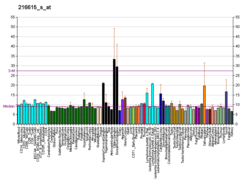5-hydroxytryptamine receptor 3A is a protein that in humans is encoded by the HTR3A gene.
The product of this gene belongs to the ligand-gated ion channel receptor superfamily. This gene encodes subunit A of the type 3 receptor for 5-hydroxytryptamine (serotonin), a biogenic hormone that functions as a neurotransmitter, a hormone, and a mitogen. This receptor causes fast, depolarizing responses in neurons after activation. The A subunit is the only one that can be expressed alone and forms homomers with a very low single channel conductance of 0.6pS. When combined with the B subunit and expressed as a heteromer, the single channel conductance increases immensely. Alternatively spliced transcript variants encoding different isoforms have been identified.
See also
References
- ^ GRCh38: Ensembl release 89: ENSG00000166736 – Ensembl, May 2017
- ^ GRCm38: Ensembl release 89: ENSMUSG00000032269 – Ensembl, May 2017
- "Human PubMed Reference:". National Center for Biotechnology Information, U.S. National Library of Medicine.
- "Mouse PubMed Reference:". National Center for Biotechnology Information, U.S. National Library of Medicine.
- Weiss B, Mertz A, Schrock E, Koenen M, Rappold G (Feb 1996). "Assignment of a human homolog of the mouse Htr3 receptor gene to chromosome 11q23.1-q23.2". Genomics. 29 (1): 304–305. doi:10.1006/geno.1995.1254. PMID 8530095.
- Kelley SP, Dunlop JI, Kirkness EF, Lambert JJ, Peters JA (Jul 2003). "A cytoplasmic region determines single-channel conductance in 5-HT3 receptors". Nature. 424 (6946): 321–324. Bibcode:2003Natur.424..321K. doi:10.1038/nature01788. PMID 12867984. S2CID 4417817.
- "Entrez Gene: HTR3A 5-hydroxytryptamine (serotonin) receptor 3A".
Further reading
- Miyake A, Mochizuki S, Takemoto Y, Akuzawa S (1995). "Molecular cloning of human 5-hydroxytryptamine3 receptor: heterogeneity in distribution and function among species". Mol. Pharmacol. 48 (3): 407–416. PMID 7565620.
- Uetz P, Abdelatty F, Villarroel A, et al. (1994). "Organisation of the murine 5-HT3 receptor gene and assignment to human chromosome 11". FEBS Lett. 339 (3): 302–306. Bibcode:1994FEBSL.339..302U. doi:10.1016/0014-5793(94)80435-4. PMID 8112471. S2CID 28979681.
- Belelli D, Balcarek JM, Hope AG, et al. (1996). "Cloning and functional expression of a human 5-hydroxytryptamine type 3AS receptor subunit". Mol. Pharmacol. 48 (6): 1054–1062. PMID 8848005.
- Brüss M, Göthert M, Hayer M, Bönisch H (1999). "Molecular cloning of alternatively spliced human 5-HT3 receptor cDNAs". Ann. N. Y. Acad. Sci. 861: 234–235. doi:10.1111/j.1749-6632.1998.tb10196.x. PMID 9928262.
- Davies PA, Pistis M, Hanna MC, et al. (1999). "The 5-HT3B subunit is a major determinant of serotonin-receptor function". Nature. 397 (6717): 359–363. Bibcode:1999Natur.397..359D. doi:10.1038/16941. PMID 9950429. S2CID 4401851.
- Brüss M, Eucker T, Göthert M, Bönisch H (2000). "Exon-intron organization of the human 5-HT3A receptor gene". Neuropharmacology. 39 (2): 308–315. doi:10.1016/S0028-3908(99)00116-1. PMID 10670426. S2CID 6002534.
- Marazziti D, Betti L, Giannaccini G, et al. (2002). "Distribution of GR65630 binding in human brain postmortem". Neurochem. Res. 26 (3): 187–190. doi:10.1023/A:1010939530412. PMID 11495540. S2CID 2548479.
- Spier AD, Lummis SC (2003). "Immunological characterization of 5-HT3 receptor transmembrane topology". J. Mol. Neurosci. 18 (3): 169–178. doi:10.1385/JMN:18:3:169. PMID 12059035. S2CID 25754984.
- Boyd GW, Low P, Dunlop JI, et al. (2002). "Assembly and cell surface expression of homomeric and heteromeric 5-HT3 receptors: the role of oligomerization and chaperone proteins". Mol. Cell. Neurosci. 21 (1): 38–50. doi:10.1006/mcne.2002.1160. PMID 12359150. S2CID 37832903.
- Hapfelmeier G, Haseneder R, Lampadius K, et al. (2003). "Cloned human and murine serotonin(3A) receptors expressed in human embryonic kidney 293 cells display different single-channel kinetics". Neurosci. Lett. 335 (1): 44–48. doi:10.1016/S0304-3940(02)01156-4. PMID 12457738. S2CID 35192275.
- Strausberg RL, Feingold EA, Grouse LH, et al. (2003). "Generation and initial analysis of more than 15,000 full-length human and mouse cDNA sequences". Proc. Natl. Acad. Sci. U.S.A. 99 (26): 16899–16903. Bibcode:2002PNAS...9916899M. doi:10.1073/pnas.242603899. PMC 139241. PMID 12477932.
- Pick H, Preuss AK, Mayer M, et al. (2003). "Monitoring expression and clustering of the ionotropic 5HT3 receptor in plasma membranes of live biological cells". Biochemistry. 42 (4): 877–884. doi:10.1021/bi026576d. PMID 12549905.
- Choi S, Lee JH, Oh S, et al. (2003). "Effects of ginsenoside Rg2 on the 5-HT3A receptor-mediated ion current in Xenopus oocytes". Mol. Cells. 15 (1): 108–113. doi:10.1016/S1016-8478(23)13715-0. PMID 12661769.
- Boyd GW, Doward AI, Kirkness EF, et al. (2003). "Cell surface expression of 5-hydroxytryptamine type 3 receptors is controlled by an endoplasmic reticulum retention signal". J. Biol. Chem. 278 (30): 27681–27687. doi:10.1074/jbc.M304938200. PMID 12750374.
- Sun H, Hu XQ, Moradel EM, et al. (2003). "Modulation of 5-HT3 receptor-mediated response and trafficking by activation of protein kinase C". J. Biol. Chem. 278 (36): 34150–34157. doi:10.1074/jbc.M303584200. PMID 12791692.
- Maksay G, Bikádi Z, Simonyi M (2004). "Binding interactions of antagonists with 5-hydroxytryptamine3A receptor models". J. Recept. Signal Transduct. Res. 23 (2–3): 255–270. doi:10.1081/RRS-120025568. PMID 14626451. S2CID 26799630.
- Kaiser R, Tremblay PB, Sezer O, et al. (2004). "Investigation of the association between 5-HT3A receptor gene polymorphisms and efficiency of antiemetic treatment with 5-HT3 receptor antagonists". Pharmacogenetics. 14 (5): 271–278. doi:10.1097/00008571-200405000-00001. PMID 15115912.
- Panicker S, Cruz H, Arrabit C, et al. (2004). "Minimal structural rearrangement of the cytoplasmic pore during activation of the 5-HT3A receptor". J. Biol. Chem. 279 (27): 28149–28158. doi:10.1074/jbc.M403545200. PMID 15131114.
External links
- HTR3A+protein,+human at the U.S. National Library of Medicine Medical Subject Headings (MeSH)
This article incorporates text from the United States National Library of Medicine, which is in the public domain.
| Ion channel, cell surface receptor: ligand-gated ion channels | |||||||||||
|---|---|---|---|---|---|---|---|---|---|---|---|
| Cys-loop receptors |
| ||||||||||
| Ionotropic glutamates |
| ||||||||||
| ATP-gated channels |
| ||||||||||
This transmembrane receptor-related article is a stub. You can help Misplaced Pages by expanding it. |





